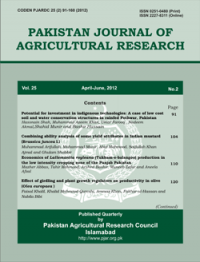EFFECT OF SPLIT N FERTILIZER APPLICATION ON PHYSIOAGRONOMIC TRAITS OF WHEAT (TRITICUM AESTIVUM L.) UNDER RAINFED CONDITIONS
Muhammad Sohail*, Imtiaz Hussain*, Riaz-ud-din*, Syed Haider Abbas*, Maqsood Qamar* and Muhammad Noman*
ABSTRACT
Low soil fertility is one of the main wheat yield limiting factors under rainfed conditions. Farmers usually apply full N dose at seeding. However, winter showers during vegetative growth period provide an opportunity to apply N in split doses. Study was conducted to find out appropriate N rate and application method to enhance wheat productivity. -1 Three N rates i.e., 60, 90, and 120 kg ha and three application methods i.e. full basal N dose at planting and N application in two and three equal split doses at tiller formation and stem elongation stages. Maximum grain yield -1 -1 (5.20 t ha ) was achieved when N was applied @120 kg ha in three equal split doses at planting, tiller formation and stem elongation stages. N application in 2 and 3 split doses resulted in 25 - 50% grain yield advantage at all N rates as compared to single basal N dose. Split N application was -2 associated with significant increase (P<0.05) in spikes m , 1000 grain weight and dry matter production. Split N application was also linked with better flag leaf chlorophyll retention and cooler crop canopies during grain filling stages which showed positive association with grain yield.
To share on other social networks, click on any share button. What are these?






